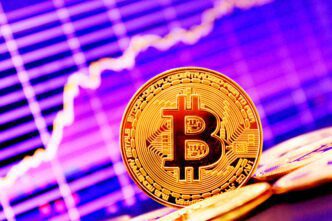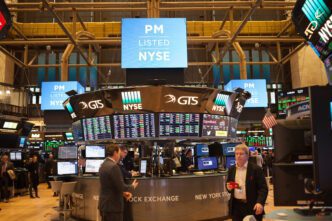U.S. stocks declined on Wednesday as investors continued to express concerns over President Donald Trump’s tariffs and the intensifying trade conflict with China. All three major stock indexes fell after Federal Reserve Chair Jerome Powell remarked that the economic impact of Trump’s policies “remains highly uncertain.” The Dow Jones Industrial Average dropped 700 points, representing a 1.7% decrease. Meanwhile, the S&P 500 fell by 2.5%, and the tech-focused Nasdaq Composite decreased by 3.5%.
“The level of the tariff increases announced so far is significantly larger than anticipated,” Powell noted at an event in Chicago. “The same is likely to be true of the economic effects, which will include higher inflation and slower growth.”
Wall Street remains engulfed in uncertainty as investors contend with the unpredictable nature of the Trump administration’s trade policies. Powell’s comments reflect concerns that have surfaced in recent weeks as both consumers and businesses navigate the effects of Trump’s tariffs. March saw a surge in consumer spending at U.S. retailers—the strongest in over two years—as Americans hurried to beat the looming tariff hikes.
Nvidia saw its stock plunge more than 8% on Wednesday after the company revealed it would incur a $5.5 billion impact due to new U.S. government restrictions on exporting its artificial intelligence chips to China. This export restriction marks another move in the growing competition between the U.S. and China for AI supremacy, a rivalry that gained momentum in January with DeepSeek’s unexpected introduction of a cost-effective, ChatGPT-like AI model, which has spurred an AI boom in China.
“While we expect that trade talks will ultimately yield progress, the brinkmanship between the U.S. and China looks set to continue in the near term,” stated Solita Marcelli, chief investment officer for the Americas at UBS Global Wealth Management, in a note on Wednesday.
Investors are keenly awaiting updates from the White House regarding any advancements in trade policy. The Trump administration launched investigations on Monday into the importation of pharmaceuticals and semiconductor chips, potentially paving the way for new tariffs, as indicated by notices in the Federal Register. Trump announced on Sunday that he would disclose a new tariff rate on imported semiconductors within the week, adding that there might be some flexibility for certain companies in the sector.
The S&P 500 had previously recorded a rare back-to-back gain on Monday, following the Trump administration’s announcement of tariff exemptions on electronics from China, alongside Trump’s consideration of exemptions for automakers. Despite this brief rally, the S&P 500 remains below its closing price from April 2, just before Trump unveiled his “reciprocal” tariffs.
According to analysts at Citi, “the recent flip-flopping around U.S. tariffs and their implementation—as evidenced by last Friday’s reprieve for tariffs on tech—suggests that market participants must brace for an extended period of uncertainty.”
The World Trade Organization recently released a report indicating that Trump’s trade war could impair global economic prospects. The WTO forecasts global GDP growth of 2.2% this year, which is 0.6 percentage points lower than it would be without additional tariffs.
The U.S. dollar index, which measures the dollar’s value against a basket of six major currencies, declined on Wednesday, marking its largest single-week drop since 2022. Additionally, the yield on the 10-year Treasury note hovered around 4.3%, a decrease from Tuesday, as investors flocked to government bonds. Meanwhile, CNN’s Fear and Greed Index registered a sentiment of “extreme fear” in the markets, with this sentiment persisting since the end of March.
This is an evolving story and will be updated as new information becomes available. Reporting contributions by CNN’s Bryan Mena and Tami Luhby.
The Bottom Line
For the everyday consumer, the ramifications of the ongoing trade tensions between the U.S. and China could mean higher prices on goods, as increased tariffs could lead to elevated costs for imported products. This scenario could dampen consumer spending, affecting economic growth and potentially leading to slower wage increases.
Industries heavily reliant on global supply chains, such as technology and manufacturing, may face significant disruptions. Companies may need to adjust their strategies, potentially impacting job stability and investment in these sectors. Meanwhile, businesses could pass the increased costs along to consumers, further affecting household budgets.
Overall, the uncertainty surrounding trade policies could impact market stability, influencing investment decisions and economic forecasts. Individuals and businesses alike should stay informed and adaptable to navigate these shifting economic dynamics effectively.








